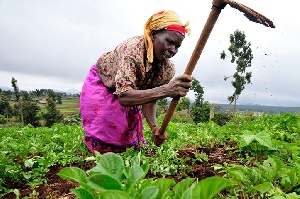- Home - News
- TWI News | TV
- Polls
- Year In Review
- News Archive
- Crime & Punishment
- Politics
- Regional
- Editorial
- Health
- Ghanaians Abroad
- Tabloid
- Africa
- Religion
- Election 2020
- Coronavirus
- News Videos | TV
- Photo Archives
- News Headlines
- Press Release
Business News of Thursday, 26 March 2015
Source: GNA
Ghanaian farmers lack access to storage facilities – survey
A survey conducted by the Ghana Trade and Livelihood Coalition (GTLC), a non-governmental organization with focus on agriculture has revealed that 82.9 per cent of rice and tomato farmers in the country did not have access to storage facilities.
The study mentioned the farmers in communities that lack storage facilities as Ohiamadwen 95.0 per cent, Nyanga 92.2per cent, Nakori 94.9per cent, Derma 98.3 per cent, Bugubelle 98.2per cent, Akomadan 100per cent and Afife 95.0 per cent.
The data was collected in 10 small-scale commercial rice and tomato production areas in nine regions; seven centres gathered information on rice and four on tomatoes, while one centre generated data on both crops.
Sixty farmers were interviewed at each centre and a total of 660 farmers were involved.
This was contained in agro-policy performance barometer report released by the GTLC and shared with some farmers, agriculture extension officers and non-governmental organisations in Takoradi in the Western Region.
The National Coordinator of GTLC, Mr. Ibrahim Akalbila, indicated that the report was the third in a series to be released in three years.
He said the 2013 report evaluated the practical effectiveness of some agriculture policies in Ghana with reference to small-scale commercial production of rice and tomato.
Mr Akalbila said the GTLC used indicators produced in Medium Term Agriculture Sector Investment Plan (METASIP) between 2011-2015 as the main basis for comparison and assessment.
He said the assessment of rice and tomato cultivation was conducted since the two crops formed the main source of livelihood and income for millions of women and men small-scale farmers in the country.
He indicated that the survey enabled an assessment of the performance of policy implementation with regards to the two crops in order to verify the success and failures of investment objectives of METASIP.
The report indicated that since 15per cent of farm produce did not have ready market with women being the main source of patrons for both rice and tomato farmers, there was the need for the government to support farmers to acquire storage facilities to ensure food security in the country.
The study also revealed that many farmers acquire skills through sheer practice and not aware of productivity-enhancing methods.
The majority of the farmers cultivated between one and five acres of land, depending on whether the farmer used tractors or hoes for land preparation.
The research showed that most farmers used government subsidized fertilizers and certified seeds and accessed credit mainly from non-banking sources and that a substantial number did not implement extension agents’ recommendations.
The study recommended that government should facilitate efficient policy implementation and develop a clear strategy that targets small-scale rice and tomato farmers to enable them store their produce to prevent post-harvest losses.











